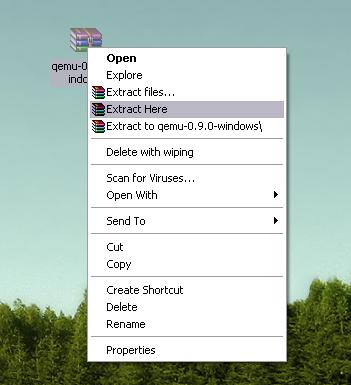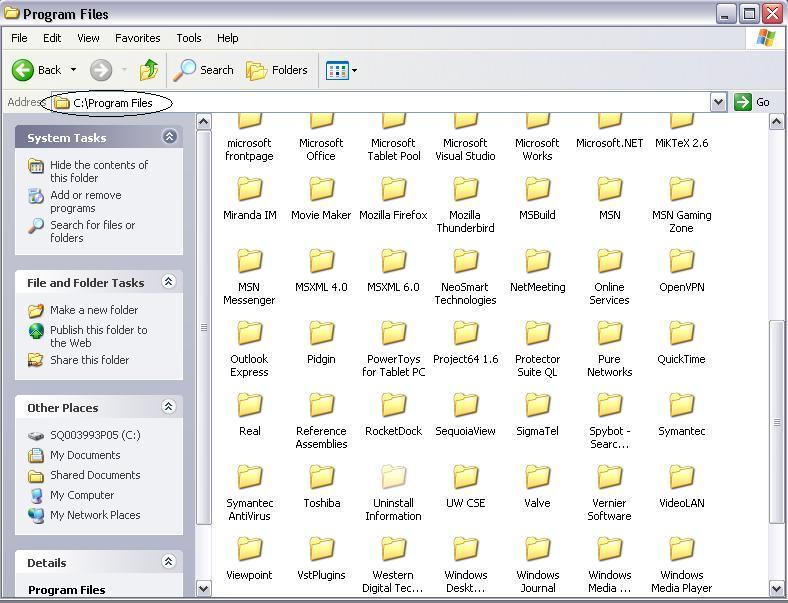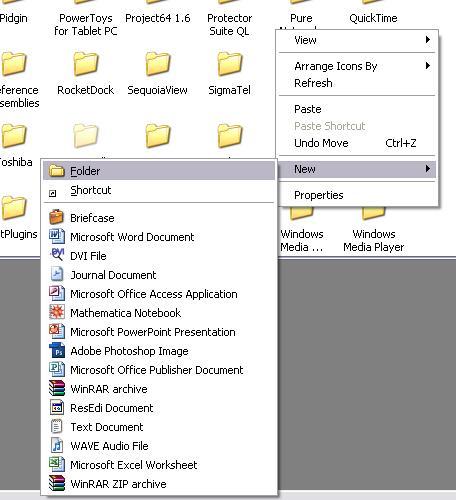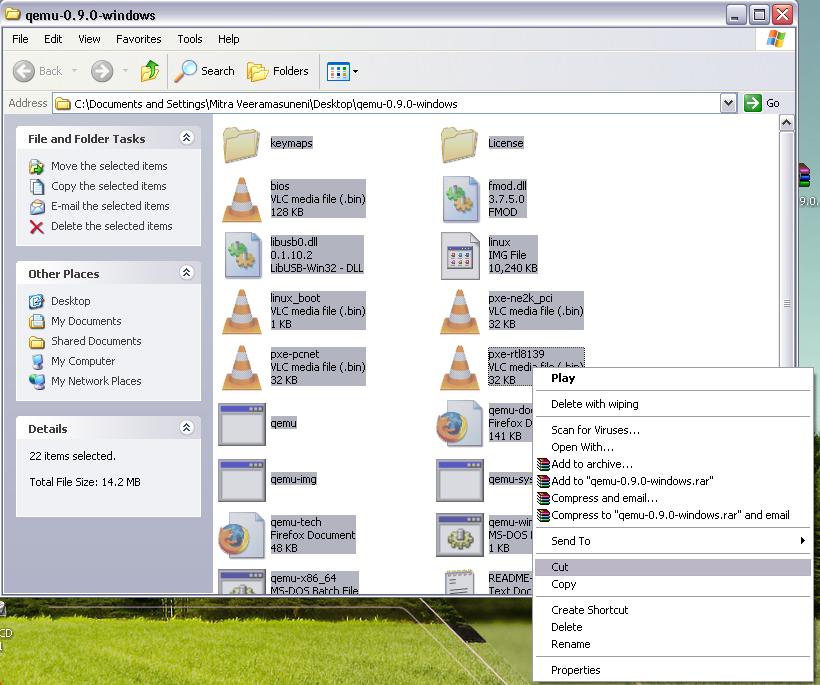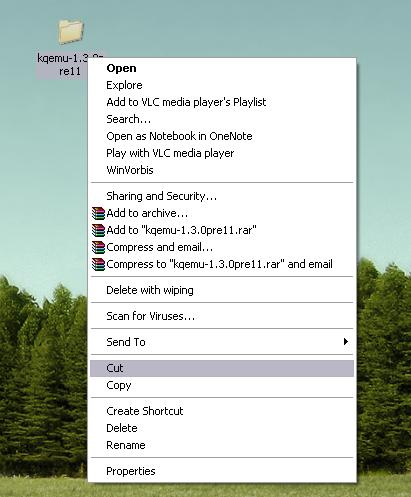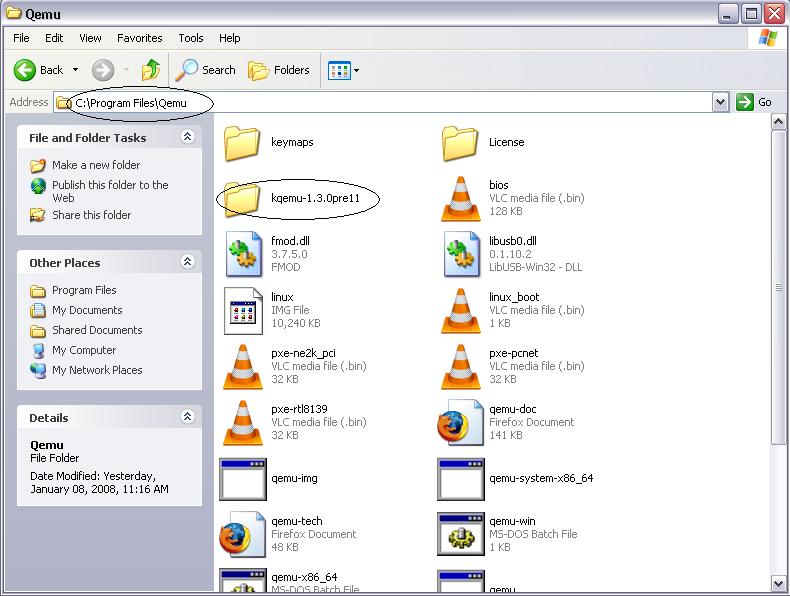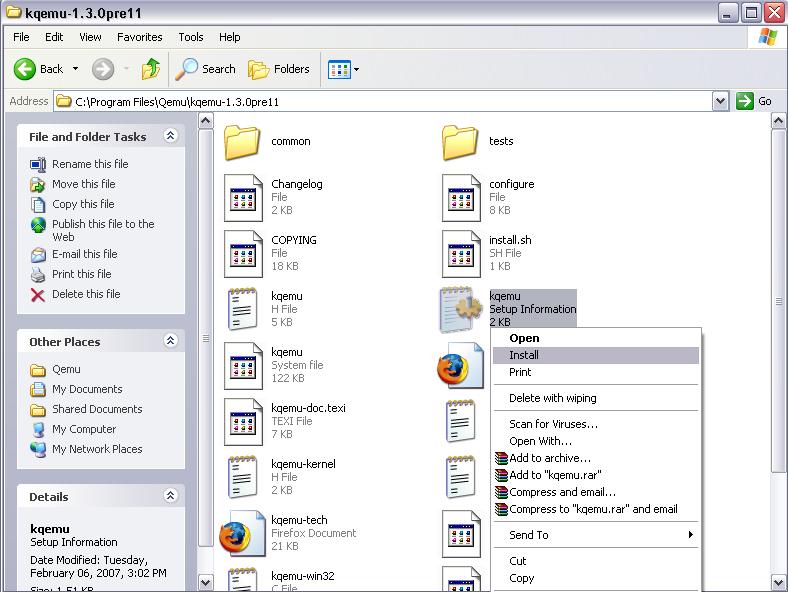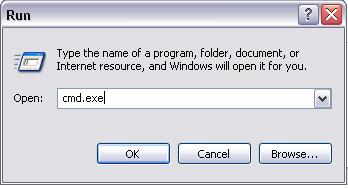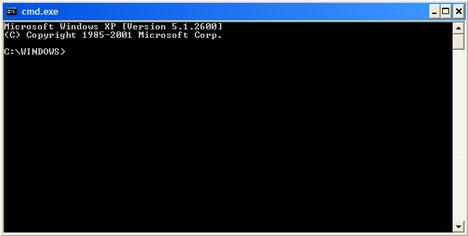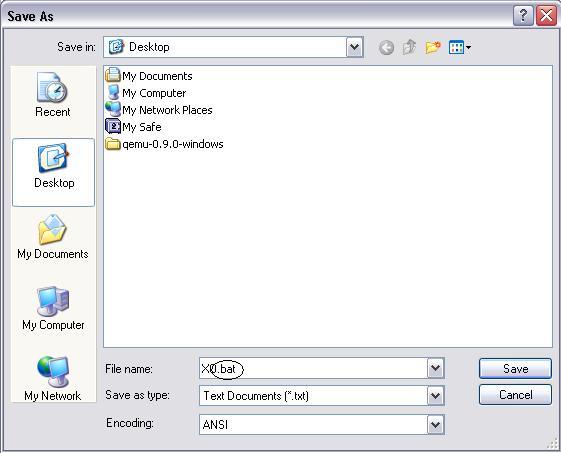Emulating the XO/Quick Start/Windows: Difference between revisions
(→Assumptions: Added Vista as an option) |
DanielDrake (talk | contribs) No edit summary |
||
| (39 intermediate revisions by 18 users not shown) | |||
| Line 1: | Line 1: | ||
<big><b><font color=red>For current information on emulation of OLPC software images, see [[Emulating the XO]]</font></b></big> |
|||
=Really Quick Start= |
|||
This instruction is meant for the first-time user who wants to try OLPC. Everything is included in a single download. |
|||
{{Deprecated}} |
|||
==Assumptions== |
|||
{{__TOCright__}} |
|||
==Installer for Windows== |
|||
The Sugar Installer for Windows includes everything you need to run Sugar on a Windows based PC: An XO-1 image, the QEMU emulator, and KQEMU to speed up emulation. An uninstaller is also included. |
|||
===Requirements=== |
|||
* Windows XP or Vista (Windows 2000 should work, not tested) |
* Windows XP or Vista (Windows 2000 should work, not tested) |
||
* About 1.5 GB free space on disk |
* About 1.5 GB free space on disk |
||
* Administration privileges on PC (as with any other software installation) |
* Administration privileges on PC (as with any other software installation) |
||
* Good Internet connection (you'll download |
* Good Internet connection (you'll download a 127 MB file) |
||
===Installation=== |
|||
Download and run the following setup file to install an 8.2.0 build using QEMU: |
|||
http://dev.laptop.org/~wadeb/OLPC-XO-Software-8.2.0-Setup.exe (127MB) |
|||
[ |
|||
] |
|||
Then go to the folder where the files got unpacked (on Windows XP that should be C:\Program Files\OLPC XO Software Release 8.2.0), right click on the file kqemu.inf and select "install" to install kqemu. |
|||
If you receive an error that you cannot install you can follow these steps: |
|||
1. "Start" -> "Run" -> enter 'cmd' |
|||
==Steps== |
|||
2. Change the directory to where the 'kqemu.inf' file is located |
|||
# Download [http://slimak.onet.pl/_m/onetlajt/olpc/olpc_qemu_full.zip olpc_qemu_full.zip] (232 MB) |
|||
> dir C:\"Program Files"\"OLPC XO Software Release 8.2.0"\ |
|||
# Doubleclick the file - it should open compressed file contents which is one directory, called '''olpc''' |
|||
3. Enter the command: |
|||
# Drag and drop this "olpc" directory somewhere, '''c:\''' recommended, but you can use different directory for that. |
|||
> rundll32 syssetup,SetupInfObjectInstallAction DefaultInstall 128 .\kqemu.inf |
|||
# Enter olpc directory and doubleclick '''start_olpc.cmd''' (if you are running Windows Vista, you should instead right-click the file and select '''Run as administrator'''). |
|||
# Enjoy! |
|||
=Next steps= |
==Next steps== |
||
{{Latest Releases | devel = inline}} |
{{Latest Releases | devel = inline | rc = inline}} |
||
* You might want to read [[Sugar Instructions]]. Sugar is the name of the graphical environment of XO. |
* You might want to read [[Sugar Instructions]]. Sugar is the name of the graphical environment of XO. |
||
* You can download another OS image, starting from ones in the green box on the right -> <br>(always pick ext3, not jffs2 version). |
* You can download another OS image, starting from ones in the green box on the right -> <br>(always pick ext3, not jffs2 version). |
||
** Remark 1: Remember, the file will be compressed with "bzip2", so you'll need to uncompress it before use. You can use [http://gnuwin32.sourceforge.net/packages/bzip2.htm Windows version of Bzip2] for that. |
** Remark 1: Remember, the file will be compressed with "bzip2", so you'll need to uncompress it before use. You can use [http://gnuwin32.sourceforge.net/packages/bzip2.htm Windows version of Bzip2] for that. |
||
** Remark 2: The start_olpc.cmd script uses first file with .img extension as a OLPC filesystem image. If you have more than one image in olpc directory, change extensions or move out all but one file. |
** Remark 2: The start_olpc.cmd script uses first file with .img extension as a OLPC filesystem image. If you have more than one image in olpc directory, change extensions or move out all but one file. |
||
* You can connect to the emulated XO by SSH, using address 127.0.0.1 and port 2222. More info [[Emulating_the_XO/Help_and_tips#Comfortably_transfer_Files_between_Host_and_XO|here]]. |
* You can connect to the emulated XO by SSH (PuTTY is one good SSH client for MS Windows), using address 127.0.0.1 and port 2222. More info [[Emulating_the_XO/Help_and_tips#Comfortably_transfer_Files_between_Host_and_XO|here]]. |
||
* You can read more about emulator: [[Emulating the XO/Help and tips]] |
* You can read more about emulator: [[Emulating the XO/Help and tips]] |
||
== Quick |
== Quick start - step by step instructions == |
||
=== QEMU === |
|||
* In order to start emulating the OLPC software, you will first need an emulator called QEMU, which can be found [http://www.h7.dion.ne.jp/~qemu-win/ here]. On the download page click the link with the name: qemu-0.9.0-windows.zip. Download the file to your desktop. |
* In order to start emulating the OLPC software, you will first need an emulator called QEMU, which can be found [http://www.h7.dion.ne.jp/~qemu-win/ here]. On the download page click the link with the name: qemu-0.9.0-windows.zip. Download the file to your desktop. |
||
** In order to use a .zip file you will need a program that has the capability to extract certain file types, we suggest |
** In order to use a .zip file you will need a program that has the capability to extract certain file types, we suggest 7-Zip which can be found [http://www.7-zip.org/ here]. Download the latest stable version, which should be the first link on the page. Install the program and you should now be able to "unzip files". |
||
* Now that you have the program extract the files to your desktop like so: |
* Now that you have the program extract the files to your desktop like so: |
||
| Line 49: | Line 68: | ||
* Qemu is now installed. |
* Qemu is now installed. |
||
== KQEMU == |
=== KQEMU === |
||
* Kqemu is an accelerator module for the Qemu emulator which improves performance on many systems. |
* Kqemu is an accelerator module for the Qemu emulator which improves performance on many systems. |
||
| ⚫ | * First, download the the module from [http:// |
||
==== KQEMU on Windows ==== |
|||
This is one method of installing Kqemu. If it doesn't work, try option 2 below. |
|||
| ⚫ | * First, download the the module from [http://wiki.qemu.org/Download here]. The stable version is kqemu-1.3.0pre11. Click on the link provided, and download the file to your desktop. As before, extract the files to the desktop by right-clicking on the file, and hitting "Extract Here". This time, instead of going into the folder and cutting all of the files separately, cut the entire folder at once, and paste it into your Qemu Program Files Folder. |
||
[[Image:Foldercut.jpg]] |
[[Image:Foldercut.jpg]] |
||
| Line 63: | Line 87: | ||
* Right Click the file, and hit "Install". It should only take a few seconds, and then the module should be installed. |
* Right Click the file, and hit "Install". It should only take a few seconds, and then the module should be installed. |
||
:* Right clicking on the .inf file and selecting Install in Vista returns the error "The INF file you selected does not support this method of installation". In Windows Vista, install KQEMU with this alternate command line from an Administrator CMD prompt: |
|||
::<tt>rundll32.exe setupapi,InstallHinfSection DefaultInstall 132 kqemu.inf</tt> |
|||
:* Another way to install KQEMU on Windows Vista uses the installer from this alternative download site: [http://www.h7.dion.ne.jp/~qemu-win/ here] --- choose the link for the executable file under "Accelerators" near the bottom of page. Download the executable file and save it on your PC. The link looks something like this: "http://www.h6.dion.ne.jp/~kazuw/qemu-win/Kqemu-1.3.0pre11-install.exe" |
|||
::* Double-click the downloaded executable file to run it. |
|||
::* When asked where to install the accelerator, choose "C:\Program Files\Qemu\Kqemu". |
|||
* Now we are going to start the module so that when you run the emulator it can access it. |
* Now we are going to start the module so that when you run the emulator it can access it. |
||
** Hit the start button, or Windows Key and then hit the "Run" button: |
** Hit the start button, or Windows Key and then hit the "Run" button: |
||
| Line 82: | Line 113: | ||
The KQEMU virtualisation module for QEMU service was started successfully. |
The KQEMU virtualisation module for QEMU service was started successfully. |
||
== Getting |
=== Getting an OLPC image === |
||
* Now that we have the basic emulator set up, its time to get the actual image that will allow us to utilize the OLPC |
* Now that we have the basic emulator set up, its time to get the actual image that will allow us to utilize the OLPC Sugar software. All the latest images can be found [http://xs-dev.laptop.org/~cscott/olpc/streams/ here]. Click on "update.1", then "latest", "devel_ext3", and then click on the image named: olpc-redhat-stream-update.1-build-657-20071212_1519-devel_ext3.img.bz2. (This is currently the latest build of the software, but feel free to go ahead and try any of the other images on the site). |
||
** |
** Here's another place to look for the latest (up to February 29, 2008) image: go to [this location http://xs-dev.laptop.org/~cscott/olpc/streams/ship.2/latest/devel_ext3/] then select file "olpc-redhat-stream-ship.2-devel_ext3.img.bz2". |
||
** As of October, 2008, the latest images can be found [here http://xs-dev.laptop.org/cscott/olpc/streams/joyride/latest/devel_ext3/]. |
|||
| ⚫ | |||
** Download the image to your desktop. |
|||
| ⚫ | |||
[[Image:Image.jpg]] |
[[Image:Image.jpg]] |
||
== The |
=== The final steps === |
||
* You are now ready to use QEMU to emulate the software. |
* You are now ready to use QEMU to emulate the software. |
||
| Line 96: | Line 129: | ||
* Now type into the box the following: |
* Now type into the box the following: |
||
cd "\Program Files\Qemu" |
cd "\Program Files\Qemu" |
||
qemu -L . -m 256 -kernel-kqemu -soundhw es1370 -net user -net nic,model=rtl8139 -hda (image name here) |
qemu -L . -m 256 -kernel-kqemu -soundhw es1370 -net user -net nic,model=rtl8139 -hda (image name here, without these brackets) |
||
*In this case the "image name" would be olpc-redhat-stream-update.1-build-657-20071212_1519-devel_ext3.img. |
*In this case the "image name" would be olpc-redhat-stream-update.1-build-657-20071212_1519-devel_ext3.img. |
||
** NOTE: When entering the code remember that this section: "model=rtl8139" should be spelled with a letter L for rtl and not the number 1 for rt1 |
** NOTE: When entering the code remember that this section: "model=rtl8139" should be spelled with a letter L for rtl and not the number 1 for rt1 |
||
| Line 114: | Line 147: | ||
* You can now use the OLPC Software, and experience the innovation of the XO on your own computer! |
* You can now use the OLPC Software, and experience the innovation of the XO on your own computer! |
||
== Easily starting up the |
=== Easily starting up the emulation === |
||
One problem with this method is that every time that you wish to run the emulation, you will need to open up the Command Prompt and type in the long command lines shown above. |
|||
You can create a .bat file which will run the commands for you with one click . |
|||
In order to do this |
|||
* |
* open up your "Notepad" which can easily be opened by opening the "Run" dialog and typing in "notepad". |
||
* Then in Notepad type in this code: |
|||
cd "\Program Files\Qemu" |
cd "\Program Files\Qemu" |
||
qemu -L . -m 256 -kernel-kqemu -soundhw es1370 -net user -net nic,model=rtl8139 -hda olpc-redhat-stream-update.1-build-657-20071212_1519-devel_ext3.img |
qemu -L . -m 256 -kernel-kqemu -soundhw es1370 -net user -net nic,model=rtl8139 -hda olpc-redhat-stream-''update.1-build-657-20071212_1519''-devel_ext3.img |
||
pause |
pause |
||
: replacing the long name of the <tt>devel_ext3.img</tt> file with the name of the image you downloaded. |
|||
* It should look like this: |
* It should look like this: |
||
[[Image:Bat.jpg]] |
[[Image:Bat.jpg]] |
||
* Now, go to File > Save and name it |
* Now, go to File > Save and name it, say <tt>XO.bat</tt>: |
||
[[Image:Saveas.jpg]] |
[[Image:Saveas.jpg]] |
||
* Save this file to your desktop and you can now click on this file at any time to run the OLPC Emulation. |
* Save this file to your desktop and you can now click on this file at any time to run the OLPC Emulation. |
||
[[Getting started]] will help you get oriented, though you may not need it. |
|||
Note: when you see the |
Note: when you see the OX icon in the center of the screen, Sugar has started. Enter you name and move the cursor to one of the corners to see the menus of sugar. |
||
You can also get other [[Emulating the XO/Help and tips|Help and tips]] on emulating Sugar. |
You can also get other [[Emulating the XO/Help and tips|Help and tips]] on emulating Sugar. |
||
When running under emulation, the sugar fonts will appear very tiny until you [https://dev.laptop.org/ticket/3681 set the screen to 200 dpi]. |
When running under emulation, the sugar fonts will appear very tiny until you [https://dev.laptop.org/ticket/3681 set the screen to 200 dpi]. ''still true'' |
||
| ⚫ | |||
| ⚫ | |||
If qemu responds with an error like "qemu: could not load PC bios '/c/Program Files/Qemu/bios.bin'" when trying to run it in the command prompt then you may have to use qemu's -L option to specify the directory where you installed qemu, which contains the bios.bin file. If you're using a 64 bit processor, you need to run the command 'qemu-system-x86_64' instead of 'qemu'. |
If qemu responds with an error like "qemu: could not load PC bios '/c/Program Files/Qemu/bios.bin'" when trying to run it in the command prompt then you may have to use qemu's -L option to specify the directory where you installed qemu, which contains the bios.bin file. If you're using a 64 bit processor, you need to run the command 'qemu-system-x86_64' instead of 'qemu'. |
||
| Line 148: | Line 181: | ||
You should now have a running "virtual XO" |
You should now have a running "virtual XO" |
||
[[Category:Emulation]] |
|||
Latest revision as of 16:14, 8 February 2011
For current information on emulation of OLPC software images, see Emulating the XO
Installer for WindowsThe Sugar Installer for Windows includes everything you need to run Sugar on a Windows based PC: An XO-1 image, the QEMU emulator, and KQEMU to speed up emulation. An uninstaller is also included. Requirements
InstallationDownload and run the following setup file to install an 8.2.0 build using QEMU: http://dev.laptop.org/~wadeb/OLPC-XO-Software-8.2.0-Setup.exe (127MB) [ ] Then go to the folder where the files got unpacked (on Windows XP that should be C:\Program Files\OLPC XO Software Release 8.2.0), right click on the file kqemu.inf and select "install" to install kqemu.
1. "Start" -> "Run" -> enter 'cmd'
2. Change the directory to where the 'kqemu.inf' file is located
> dir C:\"Program Files"\"OLPC XO Software Release 8.2.0"\
3. Enter the command:
> rundll32 syssetup,SetupInfObjectInstallAction DefaultInstall 128 .\kqemu.inf
Next steps
Quick start - step by step instructionsQEMU
KQEMU
KQEMU on WindowsThis is one method of installing Kqemu. If it doesn't work, try option 2 below.
net start kqemu
The KQEMU virtualisation module for QEMU service was started successfully. Getting an OLPC image
The final steps
cd "\Program Files\Qemu" qemu -L . -m 256 -kernel-kqemu -soundhw es1370 -net user -net nic,model=rtl8139 -hda (image name here, without these brackets)
Easily starting up the emulationOne problem with this method is that every time that you wish to run the emulation, you will need to open up the Command Prompt and type in the long command lines shown above. You can create a .bat file which will run the commands for you with one click . In order to do this
cd "\Program Files\Qemu" qemu -L . -m 256 -kernel-kqemu -soundhw es1370 -net user -net nic,model=rtl8139 -hda olpc-redhat-stream-update.1-build-657-20071212_1519-devel_ext3.img pause
Getting started will help you get oriented, though you may not need it. Note: when you see the OX icon in the center of the screen, Sugar has started. Enter you name and move the cursor to one of the corners to see the menus of sugar. You can also get other Help and tips on emulating Sugar. When running under emulation, the sugar fonts will appear very tiny until you set the screen to 200 dpi. still true Other notesIf qemu responds with an error like "qemu: could not load PC bios '/c/Program Files/Qemu/bios.bin'" when trying to run it in the command prompt then you may have to use qemu's -L option to specify the directory where you installed qemu, which contains the bios.bin file. If you're using a 64 bit processor, you need to run the command 'qemu-system-x86_64' instead of 'qemu'. Note that qemu by default gives 128 MB RAM, but according to Hardware_specification recent XO HW have 256 MB, that's why the "-m 256". To test for early XO HW (or later with more), change the -m param. Giving 256 MB RAM appears to have a noticeable effect on speed in the emulator (as I'm sure in the real HW ;)). You should now have a running "virtual XO" |

